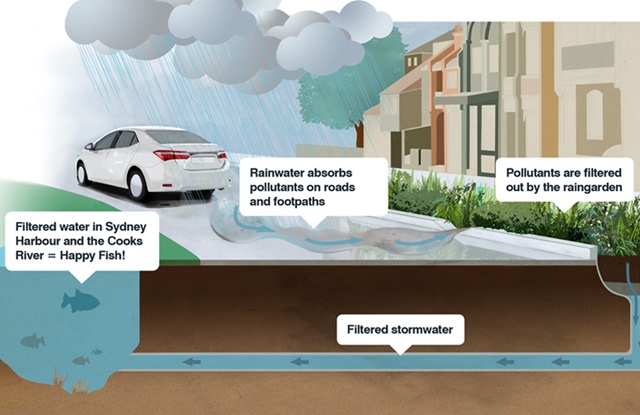City of Sydney
- GPO Box 1591Sydney 2001
- 02 9265 9333
- [email protected]
Small, green gardens play a vital role in safeguarding against harmful pollutants.
More than 150 raingardens have now been installed.
Raingardens are popping up all around Sydney and more than 150 of them have now been installed to treat stormwater, protect local waterways and green inner-city streets.

The raingardens we’re installing include water-tolerant plants such as:
We’ve chosen these plants for their ability to flourish in wet growing conditions and filtering qualities. These plants clean stormwater before it runs into waterways, removing damaging elements such as chemicals, rubbish and oils.
Stormwater runs into the gardens from hard surfaces such as streets and nearby roofs whenever it rains. Layers of select materials such as sandy soil and recycled crushed glass filter the water and allow the plants to grow and absorb the nutrients in the water. Raingardens are a way to maintain, help green the city’s streets and bring a welcome splash of nature into our streets.
We’re committed to maintaining high water quality and reducing stormwater pollution discharging into Sydney Harbour and Botany Bay.
Every year nearly 3,000 tonnes of stormwater pollutants make their way into our waterways, damaging our environment.
These beautiful green gardens play a very important role. The city now has over 2,300 square metres of raingardens that filter out pollution and contribute towards our targets to reduce sediment reaching our waterways by 50% by 2030.
The raingardens are one of many water related projects we’re undertaking in streets, parks, ovals and community centres. These initiatives replace mains water use with alternative sources and reduce discharge to the ocean.
The self-watering gardens are installed often when new traffic public works improvements are made to the city’s streets. They are typically at street corners in the space where cars can't park, and they replace what was once asphalt road pavement. By positioning them at such locations, we’re also improving safety for people walking by reducing the distance to cross the road.